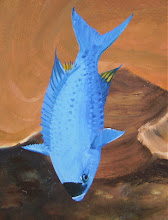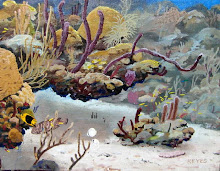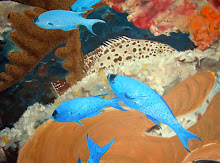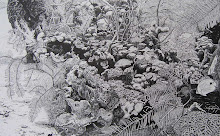.
I read a very funny-sad article about a cannon ball a fellow found in the mud while diving near a battle site from the Civil War in the Chesapeake Bay, on the east coast of the USA. The fellow was SO proud of his find! He put it on a special shelf in his living room, so he could admire his own genuine Civil War Relic. But before long, the ball started rusting. Well, what's a little rust?
.
Then he noticed the cannon ball was REALLY rusting, pieces and chunks were chipping off. The man became alarmed, and put the ball in a bucket of water. Maybe this would soak off the salt that must be on the ball from being in the salty water of the bay for so long. After a week, he gently put the ball back on its' shelf.
.
The ball still rusted, more and more bits falling off. The ball was actually becoming noticeably smaller. The man made sure the ball was completely dry, and he varnished it. Nope, still rusting and more chips falling off. By this time the ball was only 3/4 the original size.
.
As time went by, he tried other things, I forget what, but to no avail. More rusting. Less ball.
.
To his great dismay, his cannon ball was just disappearing into a little heap of rust! It had rusted away to the size of a large marble(!) surrounded by a thick bed of rusty chunks, by the time he finally learned that to preserve the cannonball, he would have had to place it in a solution of chemicals, and run an electric current through the bath for months in order to stabilize the changed metal.
.
I've seen anchors here taken from the sea and put beside someone's driveway, or on the Boardwalk in town. They rust and rust, until there's simply nothing left. After Hurricane Hugo, there was a pile of seven anchors in one place in Cane Bay. Wow! Selfish individuals took them, one by one, and now there is only one left in that place.
..........................................................................................................................
.
Christopher Columbus did stop here on his first voyage. He recorded a large island south of the 'Thousand Virgins" that he'd first found. Approaching from the north, he had no way of knowing that the island is long but narrow. He found the entrance of a bay, and thought it could be the mouth of a river. He anchored and went ashore, and was met by fierce Caribe warriors. There was a battle, and one of Columbus' men was killed. The ONE place in the Caribbean where the locals fought back.
.
Sailing away, Columbus named the bay Salt River, because he didn't get any fresh water. One anchor in this bay that people know about is embedded in coral in very shallow water, might be his, might not. Another is the one I found in deep water, pictured in yesterday's blog post. might be his, might not. They didn't engrave names in anchors back then. Still don't. as far as I know. Shipwreck people always search for the bell, for that had the name engraved, to positively identify a sunken ship.
.
A fellow came a few years ago and was telling everyone that he was going to raise the Columbus Anchor for all the world to see and admire. The Park people said, "Oh, no, you're not!" and that was that.
.
So, per your comment yesterday, Barracuda Bill, the anchor stays where it is. Is it worthless there? Could it make someone a millionaire of brought to shore? I don't know, but doubt. Most folk don't really appreciate anchors. the way you and I do.
.
Here are some photos of --my anchors-- to complete my post for today.
.
.
.
.
So how can I say they're MINE? They are, just like the anchors that have been taken away, and graced somebody's driveway for a short while, were called 'mine' by the people who took them. But the anchors really were mine, and they didn't ask me if they could take them. And the fishermen don't ask me if they can kill my fish.
.
Actually, all of St. Croix is mine. And all of the whole Earth is mine. All of it, the whole thing! Hey?
.
Thanks for stopping by!
.
Pixel 3XL DayZ Epoch Mod Image
3 years ago






.jpg)



.jpg)
.jpg)
.jpg)
.jpg)
.jpg)
.jpg)
.jpg)
.jpg)
.jpg)
.jpg)
.jpg)
No comments:
Post a Comment